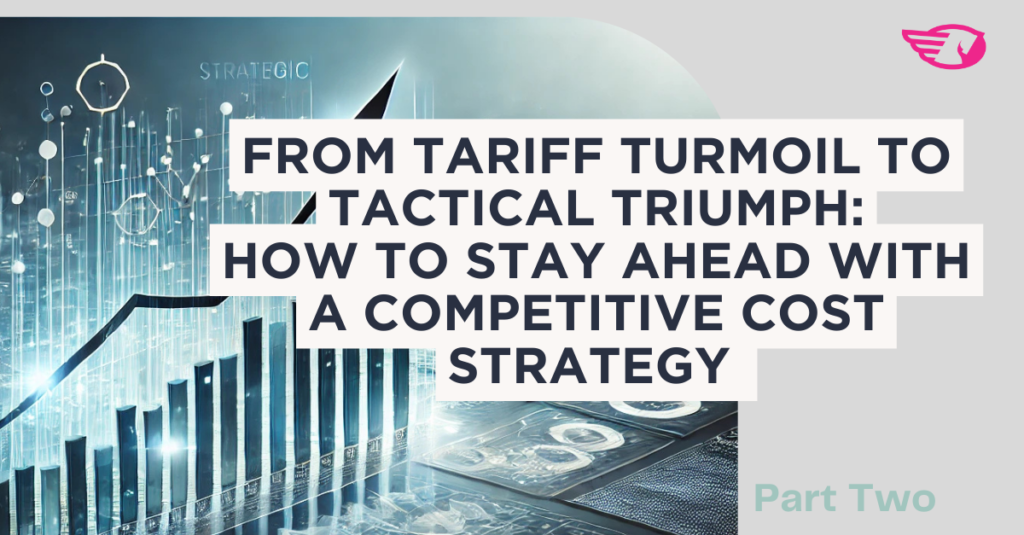
Strategic Cost Control: Thriving Admidst Tariffs
As trade winds shift and tariffs escalate, the cost of doing business globally is rising fast. For companies expanding into the U.S. or managing global supply chains, this new normal demands more than reactive measures—it requires a proactive cost strategy that transforms volatility into competitive advantage. The question isn’t if costs will rise—but how will you prepare.
At ZELOCIN & Partners, we’ve identified 4 proven cost strategies that help businesses reduce risk, protect margins, and build long-term resilience in a turbulent trade environment:
Strengthen Supplier & Customer Relationships: Stay ahead of disruptions by communicating early and often. Strong relationships lead to better planning, pricing clarity, trust & loyalty, and long-term stability.
Optimize Logistics & Reduce Freight Costs: Consolidate shipments, select optimal ports, and leverage 3PL partners to drive down transportation costs and improve cross-border efficiency.
Renegotiate Supplier Contracts & Payment Terms: Secure pricing stability and protect cash flow through extended terms, volume-based discounts, and collaborative cost-sharing agreements.
Invest in Process Efficiency & Cost Reduction: Streamline operations with automation, reduce material waste, and use smarter packaging to lower production and shipping costs.
The Bottom Line: Businesses that plan, strengthen relationships, and innovate now will lead tomorrow. From supplier negotiations to smarter logistics and operational excellence, these strategies don’t just cut costs—they build resilience and unlock long-term growth.
ZELOCIN Insights show companies implementing these strategies can improve cash flow by up to 25%, reduce freight and logistics costs by 15–20%, and lower unit costs by up to 30%. This isn’t just survival—it’s strategic positioning for sustained success.
Blog:
The trade winds are shifting course, and tariffs are sending costs soaring. Businesses expanding into the U.S. or sourcing globally are facing a stark reality: adapt or fall behind. With tariffs escalating on imports from key partners, proactive cost strategies are no longer optional—they’re essential.
So, the big question is: How do you successfully price, plan, and position your business when the trade landscape keeps shifting?
What’s at Stake?
For new market entrants:
- Higher import costs could eat into your margins before you even gain traction.
- Competitors with localized supply chains could have a pricing edge over you.
- Unpredictable regulations could stall your growth if you don’t have a strategic approach.
For companies sourcing globally:
- Raw materials and components are getting more expensive, squeezing profits.
- Supplier relationships are under pressure as costs rise and production shifts.
- Customers expect transparency—a price hike without a clear explanation could cost you their trust.
How to Stay Ahead: 4 Proven Cost Strategies
1. Strengthen Supplier & Customer Relationships – Collaboration is Everything
Why it works: Companies that frequently communicate with suppliers and customers maintain stability and stay ahead of disruptions instead of reacting to them.
How to implement it:
- Collaborative Planning: Work closely with suppliers to develop contingency plans—if tariffs increase, what’s Plan B?
- Transparent Customer Communication: If price changes are necessary, explain why. Companies that educate their customers instead of surprising them with cost increases build trust and loyalty.
- Strategic Partnerships: Look for long-term agreements with suppliers to lock in better pricing and mitigate sudden increases.
ZELOCIN INSIGHT: To overcome tariff disruptions, focus on strengthening strategic partnerships with both suppliers and customers. Research shows that proactive communication can significantly reduce the impact of disruptions—potentially lowering supply chain costs by 10–20%. Transparent pricing fosters trust and loyalty, with high-trust customers being 88% more likely to repurchase. In addition, long-term supplier agreements offer greater cost predictability and stronger negotiation leverage, helping to reduce lead times by as much as 20–30%. These actions collectively position your business for long-term resilience and competitive advantage.
2. Optimize Logistics & Reduce Freight Costs
Why it works: With rising tariffs, transportation costs can make or break your margins—efficiency is key.
How to implement it:
- Consolidate Shipments: Bulk shipping can help reduce per-unit costs and minimize customs fees.
- Optimize Port Selection: Choosing ports with lower customs processing fees and faster clearance times can cut costs and delays to keep you ahead.
- Leverage 3PL Providers: Third-party logistics (3PL) companies negotiate more attractive freight rates and specialize in streamlining cross-border operations.
Logistics in Action: Green Worldwide, a trusted leader in global logistics, freight forwarding, and international trade compliance services, leverages eco-friendly solutions that minimize costs for its customers. Its initiatives toward zero-emission shipping services, reduced carbon footprints, and freight efficiency position Green Worldwide as the sustainable, cost-effective and innovative solution for businesses’ distribution and fulfillment needs.
ZELOCIN INSIGHT: According to industry reports, optimizing port selection and consolidating shipments can reduce freight costs by up to 15%. Utilizing 3PL providers can further decrease logistics expenses by an average of 20%.
3. Renegotiate Supplier Contracts & Payment Terms
Why it works: Long-term agreements can provide pricing stability—especially when tariffs increase uncertainty.
How to implement it:
- Cost-sharing agreements: Collaborate with suppliers to split the impact of tariff increases rather than absorbing the full cost.
- Extended payment terms: Negotiating longer payment cycles improves cash flow, allowing businesses to adjust to changing costs over time and effectively manage growth.
- Volume-based discounts: Commit to larger orders in exchange for lower per-unit costs to mitigate future tariff-induced price Increases.
ZELOCIN INSIGHT: Negotiating extended payment terms can improve cash flow by up to 25%, while volume-based discounts can decrease per-unit costs by 10–15%, effectively buffering against tariff increases. On top of that, negotiating long-term agreements can reduce price volatility by up to 20%, while collaborative cost-sharing can lessen immediate financial burdens by 30-50%. These strategies not only enhance short-term liquidity but also create room for reinvestment in core operations, such as inventory optimization and supplier diversification. Additionally, building stronger financial agreements with vendors can foster long-term resilience, giving your business a sustained advantage and greater agility in navigating volatile trade conditions.
4. Invest in Process Efficiency & Cost Reduction
Why it works: If tariffs are increasing costs, your best defense is improving efficiency in production, procurement, and operations.
How to implement it:
- Automate where possible: Reducing manual labor in production and order fulfillment lowers variable costs to add a layer of protection against uncertainty.
- Source materials with higher yield rates: Using materials with minimal waste output reduces production costs and enhances operational efficiency.
- Reduce packaging & material waste: Lighter, more efficient packaging can reduce shipping and import costs—and can also be leveraged in brand messaging to enhance consumer goodwill.
ZELOCIN INSIGHT: Navigate tariffs by implementing targeted process efficiencies. Automate to reduce labor costs, source materials with higher yield rates to minimize waste, and optimize packaging for cost-effective logistics. Automation can reduce operational costs by 25%+, while efficiently sourcing materials could lower material costs by 5-10% and waste expenses by 15-20%. Optimizing packaging and shipping of materials and finished products can improve packaging and shipping fees by 10-15%, offering a comprehensive cost reduction strategy.
This is Your Moment to Lead, Not React
Tariff uncertainty isn’t going away—let’s develop a cost strategy that gives you a competitive edge. The businesses that focus on innovation, building strong supplier & customer relationships, and optimizing costs will be the ones that set the pace, not play catch-up.
